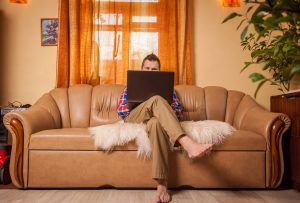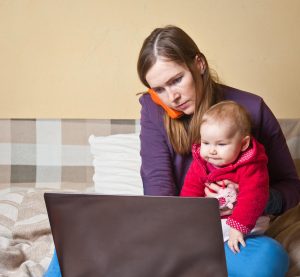Home is Where the Office Is
Rayle Rubenstein
Working from home always seemed like a dream to me – before I did it. And the truth is, I really do enjoy many things about it. The flexibility, the ability to maintain the home and be there for the kids, the lack of a work commute…What could be better? Within the last couple of years, working from home has become more common than we ever dreamed. It’s no longer just people like me, moms who work part-time: it’s lawyers, accountants, therapists and interior decorators. Employees of some of the largest companies in the country. And we can’t just blame COVID-19, as we tend to do for just about everything these days, although it certainly has played a part. According to a study by researchers at Stanford, approximately ten percent of employees in the United States worked remotely in 2013. Entrepreneur published an article that claimed “work from home is here to stay,” nearly a year-and-a-half before the pandemic struck. In September, 2021, a Gallup poll put the number of people working from home somewhere between 20 and 25 percent.
As that number continues to increase, there are lots of questions. Are we performing as well from home as we would in the office? What are we missing out on by avoiding that commute? And most importantly: how can we make working from home…work?

DOES IT WORK?
Peninah Baumgarten, who is responsible for the impressive graphic work you see right here in this article, calls working from home “a mixed bag.” She feels that people do not take her job as seriously as they would if she worked outside the home. “They ask you things they’d never ask someone who had to go to an office because they think you’re home anyway, so how busy can you possibly be?” she says.
When the kids are home sick or have vacation, Peninah is grateful to be able to stay with them without having to clear it with a boss or scramble to find a babysitter, although she still must complete her workload for the day.
She loves not having to wear office attire. “But you have to be super-disciplined and stick to a schedule. It can really mess up your day if you’re not on top of things,” she explains. Peninah avoids social media and chats, which she calls “productivity killers.” She hides her phone during work hours to avoid “falling down a rabbit hole.” “There is only a limited window of time each day to get work done, and if I squander it, I will regret it in more ways than one.”
Still, with so many distractions around, it can be a real challenge to buckle down and focus.
“You know where the nosh is when you’re in your own home,” Peninah quips. “And I also have household obligations, so that means cleaning floors or wiping down the fridge while on phone meetings. And I have to keep the never-ending laundry moving so everyone will have clean, dry sheets by bedtime and clean clothes for school the next day, so I set an alarm and run upstairs in middle of working so I can take care of that.”
Just how much of an effect do those diversions have on productivity?
That’s a question some employers ponder as their employees log in remotely from the comfort of their homes.
In 2017, IBM ordered employees working from home to return to the workplace; at the time 40% of its workforce worked remotely. Not that long ago, in December 2021, Vishal Garg, CEO of Better.com, terminated 900 employees, a full 9% of the company’s workforce, citing their underproductivity. He made the announcement over Zoom – not a great move, but one that highlighted a real problem in an employee-employer relationship that is cultivated remotely: lack of trust.
Trust may be a determining factor in the success of remote working, because despite the distractions, some studies have found that employees are actually more productive at home. Stanford’s 2013 study was conducted at Chinese travel agency Ctrip, randomly assigning call-center volunteers to work either from home or the office for a period of nine months. At the end of that period, it was determined that those who worked from home took more phone calls and worked longer hours with fewer breaks. An American call center found similar, although slightly lower, levels of productivity among remote employees between 2018 and 2020.
Working from home can be more productive for a number of reasons. Some employees find it easier to focus at home. In some cases, more flexible hours means the ability to choose to work during the most productive times of day. There’s no time wasted on a commute, no getting stuck in traffic, and no taking off because a child is sick.
THE SOCIAL ASPECT
Peninah says that while it’s nice to work solo, she does miss out on the social benefits of getting out and being around other people. “I can turn into a complete hermit sometimes,” she quips. “And while I have come to enjoy that for the most part, it’s not healthy for most people!”
For every study that shows the positive side of remote work, there’s another that highlights its problems. One of those problems is the lack of social interaction. Staying within the confines of your own four walls can impact you professionally and personally.
Researchers in England conducted a study in 2017 and found that responses at emergency call centers were quicker when the phone responders and dispatchers were in the same room instead of in separate rooms – the closer their proximity in that room, the faster their response. That’s part of the social aspect that’s missing with remote work. It’s true that you may not be interrupted by coworkers, but you also won’t have the same camaraderie and drive to work together as a team if you are only interacting via a screen. Those brainstorming sessions may not happen in the same way, and neither will your teamwork.
It’s not just your workload that may be affected. If you’ve worked at an office, your colleagues may not have been counted among your friends, but it is possible that you underestimated their influence on your social health. Interacting with others face-to-face prevents feelings of isolation, even if all that is being discussed is your work.
The mere acts of getting dressed properly, exiting your home, and going somewhere are all conducive to good mental health. Staying home in pajamas, even if you are meeting all your deadlines and accomplishing your tasks, can negatively impact your mood and energy levels.
An online survey conducted last March by the American Psychiatry Association of 1,000 respondents found that the majority of remote workers experienced feelings of loneliness and isolation.
MAKING WORK FROM HOME…WORK
Rachelie Goldberger, LCSW, whose insightful column appears in this very publication, has plenty of experience when it comes to working from home. Rachelie maintains two practices, one in Marine Park and one in Lakewood, New Jersey. When she first opened her practice in New Jersey, she alternated between seeing clients at home and in the office. “At first, I found that working in the office was more helpful as far as scheduling,” she says, “and I appreciated getting dressed and getting out. But I ended up only working from home because it was so much easier once I mastered how to do it right.”
So, what “does doing it right” mean? And how can workers at home master it as well?
“The first and most important thing,” Rachelie instructs, “is to get dressed. If you are a woman, that means wearing a sheitel and makeup. Put on the same types of clothing you’d wear to an office. If you wear pajamas or sloppy clothing, it will make you feel unproductive and gross.” On days when she has a lot of paperwork ahead of her, Rachelie really gets dressed up, because that type of work tends to drag her mood down.
If you dress well, you will also be more likely to eat well. “My clients who work on the computer in pajamas make bad food choices,” says Rachelie. “When you wear sloppy clothes, you don’t feel beautiful; that’s when you’ll keep going to the refrigerator.”

According to Rachelie, discipline is key for the diet – and for productivity. “Even if you are dressed well, it’s important to be disciplined in other ways. Set specific breaks for breakfast, lunch, and supper,” she says. Treat your home as you would your office. You wouldn’t keep opening the fridge in an office, so don’t do it at home either. Pack a salad for lunch as you would if you were working outside the home; don’t raid the pantry at mealtime. Lack of discipline will lead to weight gain, which will not lead to positive feelings.
Rachelie says to keep housework off-limits during work hours in order to maximize your productivity. “You can use your designated lunch break to throw in a load of laundry, just as you might use your break at the office to run errands,” Rachelie says. “Use your break exactly as you would if you were outside your home.” And when that break is over, it’s time to buckle down and focus on work only – not laundry.
A designated workspace will help you focus and will make your job feel more legitimate. “Set up a desk and let your family know that this is your space,” emphasizes Rachelie. “The space in front of your computer is yours alone – it is not a surface for anyone else’s papers or paraphernalia.” Peninah wears a large headset whenever she is working at her desk and makes a big show of removing them whenever anyone disturbs her. This added measure reminds her family and guests that both she and her workspace are (supposed to be) off-limits during her work hours.
PRODUCTIVE – AND HAPPY
Setting real goals is the best way to make sure you actually accomplish them. Begin each day with a list that includes tasks, deadlines, and meal breaks. Include a few tasks that you may be able to complete if you end up with extra time. Rachelie says that it’s crucial to include two more things on that list: time for socialization and exercise.
Rachelie counsels many clients who work from home. Most of them, she says, battle feelings of isolation and some are depressed. A few have expressed their desire to quit their jobs altogether; they’ve told Rachelie that they’d rather lose their income than feel so lonely.
But working from home doesn’t have to mean isolation.
“During your lunch hour, you can socialize,” explains Rachelie. “Go for a walk with a friend or make a phone call. One of the benefits of working from home is that you can be a little more flexible with your schedule. Make it a rule to designate an hour or two each week outside of your lunch break for socializing, and make sure that no matter what else happens in your life, you stick to it.”
While doing research for her college thesis, Rachelie found that the highest levels of depression and suicide were among toll booth collectors and dentists. Dentists see people, but their patients can’t really carry a conversation. And toll booth collectors have little to no opportunities for real interaction during their workdays. “Being at home,” Rachelie surmises, “is a little like being locked into your own little toll booth. You have to make sure you get out regularly.”
Taking a power walk once or twice a day – Rachelie suggests 15 minutes each – will get your endorphins going and keep you from stagnating in front of your computer for eight hours straight. Regular exercise – three 30-minute workout sessions per week – will keep you in shape physically. If you can’t make time for that workout during the day, do it at night.
“Getting dressed, designating social time, and carving out time for walks and exercise make all the difference,” concludes Rachelie. She works with her clients to build a work from home schedule that includes all three, along with specific times for work and meals. “It’s like a lifeline.”

HERE TO STAY
Jim Clifton, CEO of Gallup, wrote in December, “When the pandemic wanes and something close to “normal” returns, we conclude that there will be a 37% reduction of in-person days worked per week for those 60 million employees who can work from home. Put another way, a tall office building in a big city where all desk jobs can be done remotely — on any given week — will have 37% fewer desks occupied than it did that same week in 2019.”
Working from home can be a good thing – or a bad thing. It can increase productivity, or it can decrease it. It can lead to higher levels of satisfaction, or to depression. But one thing seems to be certain: the number of those working from home will continue to increase even as the pandemic wanes. Clearly, it’s working for many.
Despite the challenges of working from home, Peninah would not want things any other way. “I truly appreciate being able to stay home and be my own boss. I can take the jobs I want, and I can arrange my own schedule. I can pick up and go away with the family for holidays or simchos without reporting to any higher-ups,” she says. “It’s been an absolute blessing for me.”
I agree.
And with that, I will sign off. It’s time for my work-at-home lunch break. | JE
Sources:
“As Americans Begin to Return to the Office, Views on Workplace Mental Health Are Mixed.” American Psychiatric Association, May 2021.
Battiston, Diego, et al. “Is Distance Dead? Face-to-Face Communication and Productivity in Teams.” Management Centre for Economic Performance, LSE Research Online, March 2017.
Bloom, Nicholas, et al. “Does Working from Home Work?” Stanford Graduate School of Business,
March 2013.
Clifton, Jim. “Bet on It: 37% of Desks Will Be Empty.” Gallup, December 2021.
Joshi, Vaibhav. “Does Working from Home Actually Work?” Entrepreneur, October 2018.
Saad, Lydia and Ben Wigert. “Remote Work Persisting and Trending Permanent.” Gallup, October 2021.
You must be logged in to post a comment.